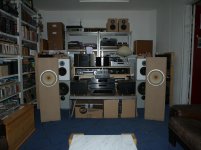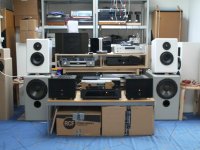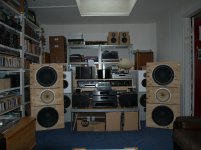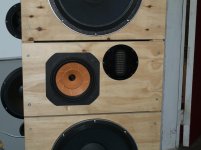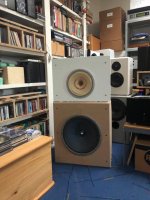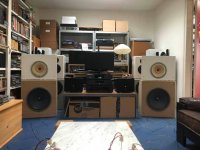Voxativ
AC-XHB 98 dB (60Hz) / 110dB (4 kHz) 1W / 1m
AC-X2 96 dB (60Hz) / 102dB (4 kHz) 1W / 1m
AC-X 95 dB (60Hz) / 101dB (4 kHz) 1W / 1m
AC-4Ф Silver 96 dB (60Hz) / 105dB (5 kHz) 1W / 1m*
AC-4Ф Gold 97 dB (60Hz) / 106dB (5 kHz) 1W / 1m*
AC-4a 96 dB (60Hz) / 101dB (3 kHz) 1W / 1m*
AC-4x 96 dB (60Hz) / 101dB (3 kHz) 1W / 1m*
AC-PiNd 93 dB (60Hz) / 98dB (3 kHz) 1W / 1m*
AC-2.6 93 dB (60Hz) / 98dB (3 kHz) 1W / 1m*
AC-PiFe 94 dB (60Hz) / 100dB (3 kHz) 1W / 1m*
AC-1.6 94 dB (60Hz) / 100dB (3 kHz) 1W / 1m*
AF–2.6 94 dB (60Hz) / 99 dB (3 kHz) 1W / 1m*
philips ad1255 98db
Lowther PM4 98 db
PM5 98 db
EX4 99 db
EX3 98 db
Fostex FE208EΣ 97 dB
Special FE208-SOL 96 db
Nirvana Super 8 NEODYMIUM 100 db
Nirvana Classic 8 NEODYMIUM 100 db
altec 755c 96 db
Supravox 215 GMF 40W / 97dB /
ELECTRO MAGNET SPEAKER LB12EX 97.8 dB
ELECTRO MAGNET SPEAKER LB12MKII 97.5 dB
Any else?
AC-XHB 98 dB (60Hz) / 110dB (4 kHz) 1W / 1m
AC-X2 96 dB (60Hz) / 102dB (4 kHz) 1W / 1m
AC-X 95 dB (60Hz) / 101dB (4 kHz) 1W / 1m
AC-4Ф Silver 96 dB (60Hz) / 105dB (5 kHz) 1W / 1m*
AC-4Ф Gold 97 dB (60Hz) / 106dB (5 kHz) 1W / 1m*
AC-4a 96 dB (60Hz) / 101dB (3 kHz) 1W / 1m*
AC-4x 96 dB (60Hz) / 101dB (3 kHz) 1W / 1m*
AC-PiNd 93 dB (60Hz) / 98dB (3 kHz) 1W / 1m*
AC-2.6 93 dB (60Hz) / 98dB (3 kHz) 1W / 1m*
AC-PiFe 94 dB (60Hz) / 100dB (3 kHz) 1W / 1m*
AC-1.6 94 dB (60Hz) / 100dB (3 kHz) 1W / 1m*
AF–2.6 94 dB (60Hz) / 99 dB (3 kHz) 1W / 1m*
philips ad1255 98db
Lowther PM4 98 db
PM5 98 db
EX4 99 db
EX3 98 db
Fostex FE208EΣ 97 dB
Special FE208-SOL 96 db
Nirvana Super 8 NEODYMIUM 100 db
Nirvana Classic 8 NEODYMIUM 100 db
altec 755c 96 db
Supravox 215 GMF 40W / 97dB /
ELECTRO MAGNET SPEAKER LB12EX 97.8 dB
ELECTRO MAGNET SPEAKER LB12MKII 97.5 dB
Any else?
Fane 12-250tc, Fane 15-300tc both efficient and play to 16KHz+
Fane also post frequency response charts unlike the $59,000 driver? would like to see some detailed info on that one, is it really much better than a hundred dollar Fane?
Fane also post frequency response charts unlike the $59,000 driver? would like to see some detailed info on that one, is it really much better than a hundred dollar Fane?
Last edited:
You need to know the FR and where the sensitivity or efficiency lies. SOme of these drivers have over a 10 dB (or more) lift over their bandwidth and if the number is pulled off at a higher frequency so is actually much more optimistic than in real life.
Also, some of those highly sensitive drivers have a very low Q to get tat hi efficiency, and it becomes very hard to get any real bass extention.
Take the FE206 for instance. Not a slow a Q and you can get good bass out of a (big) hornenclosure to lift the LF up to meet the HF, but if the Q gets too low you also need a front horn — or heavy EQ as Martin did with his Lowther ML-TLs (ended up 90 dB for a 99 dB (or something like that)).
Also you have to know whether they are properly quoting efficiency (1w/1m) or sensitivity (2.83v/1m). The wrong units are all too often used.
The Visaton B200 is properly rated at 2.83v/1w but the 96 dB is some 5-6 dB optimistic because of the rising top end. This is mostly fixed by phase plugs, but one will find lots of talk about use of filters (a band-aid that doesn’t really fix the problem, only the pain).
dave
Also, some of those highly sensitive drivers have a very low Q to get tat hi efficiency, and it becomes very hard to get any real bass extention.
Take the FE206 for instance. Not a slow a Q and you can get good bass out of a (big) hornenclosure to lift the LF up to meet the HF, but if the Q gets too low you also need a front horn — or heavy EQ as Martin did with his Lowther ML-TLs (ended up 90 dB for a 99 dB (or something like that)).
Also you have to know whether they are properly quoting efficiency (1w/1m) or sensitivity (2.83v/1m). The wrong units are all too often used.
The Visaton B200 is properly rated at 2.83v/1w but the 96 dB is some 5-6 dB optimistic because of the rising top end. This is mostly fixed by phase plugs, but one will find lots of talk about use of filters (a band-aid that doesn’t really fix the problem, only the pain).
dave
PRV 5MR450-NDY-8 94dB at 2.83V (can handle 225w thermal input)
https://www.parts-express.com/pedocs/specs/294-2705--prv-audio-5mr450-ndy-specifications.pdf
If you put them in parallel you would get +6dB and 4ohm nominal load for 100dB at 2.83v.
Thread discussing use and sound:
PRV 5MR450-NDY for FAST/WAW applications
https://www.parts-express.com/pedocs/specs/294-2705--prv-audio-5mr450-ndy-specifications.pdf
If you put them in parallel you would get +6dB and 4ohm nominal load for 100dB at 2.83v.
Thread discussing use and sound:
PRV 5MR450-NDY for FAST/WAW applications
Last edited:
talaerts, indeed, the different frequency response charts are hard to compare. But at least having a properly measured response gives you some form of information, on which one can form an opinion.
IMO spending thousands of $ on a single driver, with no data to support the decision, seems a bit weird to me.
But maybe it's for other people than me, that can afford to spend that much on a whim.
IMO spending thousands of $ on a single driver, with no data to support the decision, seems a bit weird to me.
But maybe it's for other people than me, that can afford to spend that much on a whim.
talaerts, indeed, the different frequency response charts are hard to compare. But at least having a properly measured response gives you some form of information
If you plug the Fs, Vas and Qes into a calculator, you'll get a reality-based answer, that makes different drivers easy to compare. Put every known driver into a spreadsheet, order it, and you'll find your winner.
HiFi Loudspeaker Design
As a rough guide:
Driver X advertised number = 94dB
X 'real' calculated efficiency = 91dB
Like any calculation based on TS calculations, this hypothetical 91dB will only be accurate for the small signal response near Fs (that is: what dave and talaerts say about uneven FR plots does apply).
...but if you listen off axis and/or if you EQ for ~flat response, this hypothetical 91dB is what your final system sensitivity will actually be - at best*. If you include baffle step compensation, you'll lose more.
That is: after EQ for flat response to ~Fs, driver X gets you about 88dB, not the advertised 94dB.
*the exception being if you use a front horn AND get it just right, so the horn boost blends seamlessly with the driver's rising response. As far as I know, none of the systems using larger FR drivers do get it just right, no matter how much they cost / brag.
e.g Martin Seddon seems to be a good guy who publishes real info. If you look at his (mislabeled) FR plot for a $$ Lowther in a front horn, you'll see it has a ~10dB hole centred at 1kHz .
Azurahorn -Le Cleac'h Acoustic Horns - Products
I've never seen a published FR plot for Oris and similar horns, but I assume they are pretty similar to the Azura; if they were better, they'd flaunt it.
I do not believe this claim: "Extraordinary sensitivity (up to 114dB!)"
Craig, yes of course theres the TS parameters to calculate relative sensitivity, but that does not help much on the higher part of the frequency spectrum. And the lack of 3rd party measurements of things like the AER drivers, and seemingly no off axis plots, makes me somewhat cautious about all of them.
But it's really hard to say anything really, it would be empty opinions all over.
Who knows? Maybe all these things are magical and have flat response from 0-60 degrees?
I'd really like to listen to one though. Same for those fancy horns, not willing to sell my internal organs for them, but would be fun to get a real life impression with my own music selection.
Edit:
I am at the very least very happy that the 15-300TC where so cheap.
But it's really hard to say anything really, it would be empty opinions all over.
Who knows? Maybe all these things are magical and have flat response from 0-60 degrees?
I'd really like to listen to one though. Same for those fancy horns, not willing to sell my internal organs for them, but would be fun to get a real life impression with my own music selection.
Edit:
I am at the very least very happy that the 15-300TC where so cheap.
Last edited:
TS parameters to calculate relative sensitivity, but that does not help much on the higher part of the frequency spectrum..
For a 'pure' full range driver system that's:
1) just 1 driver per channel
2) in a regular 'box' (sealed, ported, TL, whatever - anything without a front horn)
3) flat across a decent chunk of the audible range (say 50-10,000Hz)
...the calculated sensitivity around Fs does matter, because that's often the least efficient part of the range. If you want a reasonably balanced system, you have to pad everything else down to match that.
e.g. this project:
Measurement of the Finished Enclosure and Correction Filter Design
Those FR plots show that the efficiency from 50Hz to 200Hz is only 85-90dB*.
The DX3 speaker that was advertised as 95-98dB efficient, but the finished system (with correction circuit) is clearly less efficient than this.
*in his workshop measurements. He implies that the final (smaller?) listening room will give more boost <200Hz.
I completely agree, and it seems that perhaps I misunderstood talaerts comment regarding "ski slope f curves".
I was under the impression that the often rising response in higher frequencies of large drivers was the point of this comment.
But I am ofcourse very aware that the biggest problem with "fullrange" drivers, is the very fact that the vast majority of them are most definitely not: Full Range.
This was one of the many reasons I bought the Fane 15-300TC to begin with.
I was under the impression that the often rising response in higher frequencies of large drivers was the point of this comment.
But I am ofcourse very aware that the biggest problem with "fullrange" drivers, is the very fact that the vast majority of them are most definitely not: Full Range.
This was one of the many reasons I bought the Fane 15-300TC to begin with.
So I guess the morale of the story would be that we have different views on what a ski slope might look like.
A very boring ski slope for me would be straight, relaxed angles, with no bumps, low speed, wide area, rotten snow, no fun at all. Predictable and horrible...
A fun ski slope would have variety of angles, variety of twists and turns, several possible routes, some options for off-piste/through the woods in un-treated snow. This would also be the case for a good cross country ski track. Variation is the key!
Now, if there was a discussion that used the landing slope of a ski jump as a metaphor, there would be no question.
Not defending myself here, just sayin' I really missed the mark completely.
Anyway, the Supravox 215 EXC seems to be a unit that should most definitely be on OP's list. And maybe it would be possible to coax out some low end on the 165 EXC with some creative thinking large box design.
If the intended application would be together with another solution for bass, then it's a completely different scenario.
Edit:
I still think we're having two different discussions Craig.
A very boring ski slope for me would be straight, relaxed angles, with no bumps, low speed, wide area, rotten snow, no fun at all. Predictable and horrible...
A fun ski slope would have variety of angles, variety of twists and turns, several possible routes, some options for off-piste/through the woods in un-treated snow. This would also be the case for a good cross country ski track. Variation is the key!
Now, if there was a discussion that used the landing slope of a ski jump as a metaphor, there would be no question.
Not defending myself here, just sayin' I really missed the mark completely.
Anyway, the Supravox 215 EXC seems to be a unit that should most definitely be on OP's list. And maybe it would be possible to coax out some low end on the 165 EXC with some creative thinking large box design.
If the intended application would be together with another solution for bass, then it's a completely different scenario.
Edit:
I still think we're having two different discussions Craig.
Last edited:
Check out Lii audio fast 10 or crystal 10, I am using fast 10 in my workshop in two different boxes bass reflex and tqwt to evaluate these drivers. Very good indeed and most likely will replace my current speakers in my listening room. 99db
Lii audio
Not someone oi had heard of before.
Lii Audio, unique speaker, amplfier, quality and cost-saving parts for HiFi DIY – Online showcase for unique special DIY parts for HiFi amateurs.

dave
That's it Dave, very impressive. Over the years I've owned front horns, ob's and box speakers, I've owned lowthers and heard voxativ field coils and other exotic drivers and these are up there with the best of them. Better than lowthers as they do great bass and no spikes in the mid. They do need a fairly big box though
Have to agree with Paul 🙂
The Crystal 10 by Lii Audio belongs in my top 3 !!
I have them now running for several weeks and last 2 days I spend comparing them with another set.
Been listening to 2 sets last week.
3 way with Morel Supreme tweet , Carboncone mid and Eton 11 inch. This set is very happy with my Zappulse amps 🙂
Second set is Lii Audio Crystal 10 in a TQWP with a contour.
Running with a Musical Fidellity A120 amp.
Wel : there is NO winner here !!
If you think the Cristal 10 is expensive ?
When looking from this side : it's very cheap !!
For next week : my PAP Neo 15 set with Aurel Bryan 8 and Mundorf AMT ?
Have fun you all out there.
For my Leonidas XO for PAP , I used many Fr drivers. This one was a complete possitive surprise 🙂
The Crystal 10 by Lii Audio belongs in my top 3 !!
I have them now running for several weeks and last 2 days I spend comparing them with another set.
Been listening to 2 sets last week.
3 way with Morel Supreme tweet , Carboncone mid and Eton 11 inch. This set is very happy with my Zappulse amps 🙂
Second set is Lii Audio Crystal 10 in a TQWP with a contour.
Running with a Musical Fidellity A120 amp.
Wel : there is NO winner here !!
If you think the Cristal 10 is expensive ?
When looking from this side : it's very cheap !!
For next week : my PAP Neo 15 set with Aurel Bryan 8 and Mundorf AMT ?
Have fun you all out there.
For my Leonidas XO for PAP , I used many Fr drivers. This one was a complete possitive surprise 🙂
Attachments
Hi Leon, how are you finding the Crystal 10's after a couple of months? I saw your design on TQWT for this speaker and I think you have a winner for me, however, that is solely based on your description and of some others on several forums.
Currently I have a set of B&W 803 matrix Series 2 (2,5 way floorstander) speakers which I have inherited and I have been happy with. I think it is not the most detailed though, as well as wobbly in the bass. I would like to build my first speaker and am intrigued by FR designs. My question to you would be, how does it fare as an allround speaker, dealing with all kinds of music? Does it need any assistance in the low's when using your tqwt?
Thanks and groeten vanuit het norse westen😉
Currently I have a set of B&W 803 matrix Series 2 (2,5 way floorstander) speakers which I have inherited and I have been happy with. I think it is not the most detailed though, as well as wobbly in the bass. I would like to build my first speaker and am intrigued by FR designs. My question to you would be, how does it fare as an allround speaker, dealing with all kinds of music? Does it need any assistance in the low's when using your tqwt?
Thanks and groeten vanuit het norse westen😉
- Home
- Loudspeakers
- Full Range
- Most efficient fullrange
